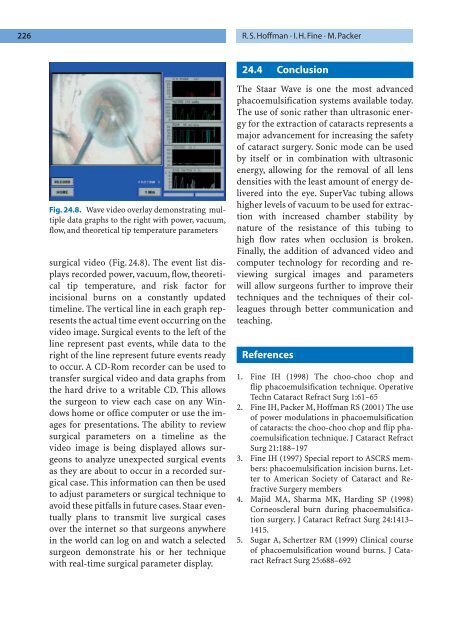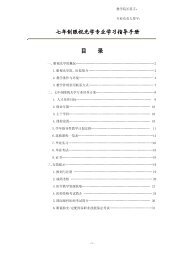Refractive Lens Surgery
Refractive Lens Surgery
Refractive Lens Surgery
You also want an ePaper? Increase the reach of your titles
YUMPU automatically turns print PDFs into web optimized ePapers that Google loves.
226 R.S. Hoffman · I.H. Fine · M. Packer<br />
Fig. 24.8. Wave video overlay demonstrating multiple<br />
data graphs to the right with power, vacuum,<br />
flow, and theoretical tip temperature parameters<br />
surgical video (Fig. 24.8). The event list displays<br />
recorded power, vacuum, flow, theoretical<br />
tip temperature, and risk factor for<br />
incisional burns on a constantly updated<br />
timeline. The vertical line in each graph represents<br />
the actual time event occurring on the<br />
video image. Surgical events to the left of the<br />
line represent past events, while data to the<br />
right of the line represent future events ready<br />
to occur. A CD-Rom recorder can be used to<br />
transfer surgical video and data graphs from<br />
the hard drive to a writable CD. This allows<br />
the surgeon to view each case on any Windows<br />
home or office computer or use the images<br />
for presentations. The ability to review<br />
surgical parameters on a timeline as the<br />
video image is being displayed allows surgeons<br />
to analyze unexpected surgical events<br />
as they are about to occur in a recorded surgical<br />
case. This information can then be used<br />
to adjust parameters or surgical technique to<br />
avoid these pitfalls in future cases. Staar eventually<br />
plans to transmit live surgical cases<br />
over the internet so that surgeons anywhere<br />
in the world can log on and watch a selected<br />
surgeon demonstrate his or her technique<br />
with real-time surgical parameter display.<br />
24.4 Conclusion<br />
The Staar Wave is one the most advanced<br />
phacoemulsification systems available today.<br />
The use of sonic rather than ultrasonic energy<br />
for the extraction of cataracts represents a<br />
major advancement for increasing the safety<br />
of cataract surgery. Sonic mode can be used<br />
by itself or in combination with ultrasonic<br />
energy, allowing for the removal of all lens<br />
densities with the least amount of energy delivered<br />
into the eye. SuperVac tubing allows<br />
higher levels of vacuum to be used for extraction<br />
with increased chamber stability by<br />
nature of the resistance of this tubing to<br />
high flow rates when occlusion is broken.<br />
Finally, the addition of advanced video and<br />
computer technology for recording and reviewing<br />
surgical images and parameters<br />
will allow surgeons further to improve their<br />
techniques and the techniques of their colleagues<br />
through better communication and<br />
teaching.<br />
References<br />
1. Fine IH (1998) The choo-choo chop and<br />
flip phacoemulsification technique. Operative<br />
Techn Cataract Refract Surg 1:61–65<br />
2. Fine IH, Packer M, Hoffman RS (2001) The use<br />
of power modulations in phacoemulsification<br />
of cataracts: the choo-choo chop and flip phacoemulsification<br />
technique. J Cataract Refract<br />
Surg 21:188–197<br />
3. Fine IH (1997) Special report to ASCRS members:<br />
phacoemulsification incision burns. Letter<br />
to American Society of Cataract and <strong>Refractive</strong><br />
<strong>Surgery</strong> members<br />
4. Majid MA, Sharma MK, Harding SP (1998)<br />
Corneoscleral burn during phacoemulsification<br />
surgery. J Cataract Refract Surg 24:1413–<br />
1415.<br />
5. Sugar A, Schertzer RM (1999) Clinical course<br />
of phacoemulsification wound burns. J Cataract<br />
Refract Surg 25:688–692



